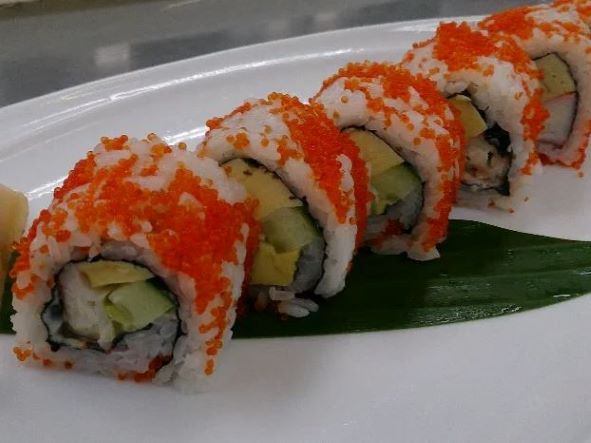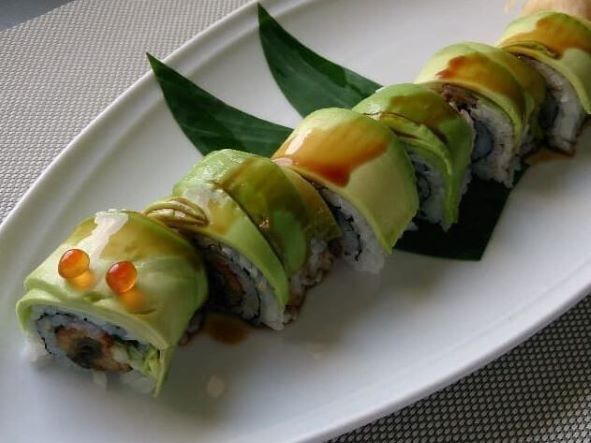
California roll is an uramaki containing imitation crab, avocado, and cucumber and often the outer layer of rice is sprinkled with tobiko.
The original sushi roll, the “California roll” was invented in the early 1970s when a Japanese chef in a Little Tokyo district used avocado in sushi rolls for the first time (some say this first happened in Vancouver, Canada).
At the time there was no custom of eating raw fish in North America and the characteristic black color and taste of Nori wasn’t well-received either. Therefore, the chef used avocado, which has a texture that resembles that of Toro, and rolled in King crab legs and mayonnaise (an American favorite) with the Nori on the inside of the rice in the Uramaki format. This was a desperate attempt of the chef to get Americans to accept sushi.
It worked wonderfully and the California roll took off and became a driving force for sushi. Even now Uramaki, mayonnaise and avocado are used in a variety of Sushi rolls. The California roll is the starting point of the wide variety of Sushi rolls available today.
Just what sort of sushi did the California roll evolve from?
Apparently before the California roll existed, Americans found Nori revolting and peeled it off of sushi before eating. It’s not hard to imagine that happening with the Norimaki (also known as Makizushi) served in sushi restaurants. These were prepared by Japanese sushi chefs and probably included Hosomaki such as Kanpyomaki, Kappamaki and Tekkamaki. We haven’t seen any literature that specified which rolls were being served at that time but it was likely these.
Let’s take this opportunity to look at the history of Makizushi in Japan, which actually goes further back than Nigiri sushi. There is an entry in a cookbook published in 1776 that is undeniably Makizushi and lists many ingredients so perhaps it was something like Futomaki. Considering that Nigiri sushi was conceived between 1810 and 1830, Makizushi predates it. However, it wasn’t until the late Meiji period that common people began to eat Nori. During the Edo period the shogunate government ruled and production was only allowed in Edo.
So then, when did the Hosomaki that California rolls were originated from first appear on the scene?
The exact year is unknown, but Morisada Manko (issued for a span of around 30 years starting in 1837), an historical account of life in the Edo period, has illustrations of types of Edo Nigiri sushi as well as Makizushi and mentions Norimaki such as Kampyo Hosomaki. In other words, Hosomaki came about around the same time as Nigiri sushi.
Around 200 years have passed since Hosomaki was invented. Although ingredients were altered in Japan, for the most part the shape has been maintained over that time. On the other hand, over the 50 years since Sushi rolls were invented, they have gained popularity throughout the world beyond America and they continue to evolve. Perhaps we can say that Hosomaki is the first generation and Sushi rolls are the second generation. While they are both Makizushi, Sushi rolls are really a new type. Sushi rolls have taken the spotlight from the original Hosomaki and are now synonymous with “Sushi” throughout the world and the differentiation continues today.
Next, let’s take a closer look at the wide variety of sushi rolls that have gained popularity throughout the world.
In Brazil, Monkey rolls have become popular. A whole banana serves as the core and the rice is rolled on the outside of the Nori. Next, mango slices are lined up on the outside and the roll is finished up with chocolate sauce on top. However, this is not made to be part of the meal, but a dessert. Another is the Guava roll, which pairs with it perfectly, like Romeo and Juliet. This sushi roll uses guava and cream cheese as the core and is also topped with chocolate sauce.
A similar dessert sushi can be found in Russia. This is called the “Sweet Roll” and it is a novel roll made from lightly mashed rice rolled with strawberries, kiwi and banana, then sprinkled with coconut powder and finally drizzled with condensed milk and strawberry sauce.
Romania also has a dessert sushi called a Chocolate banana roll. What makes this roll special is that no Nori is used and the banana and chocolate spread are placed on top of the rice before rolling. It is topped with finely crushed peanuts and diced oranges, giving it a bright, colorful appearance.
In Germany, although it is not considered to be a dessert sushi, there is one roll made with cheese, smoked salmon, apple and cilantro. Mango rolls have become a staple in the UK. The ingredients are avocado, imitation crab, shrimp tempura rolled all rolled with the rice on the outside, and sliced mango substituted for Nori. A creamy mango sauce is used for drizzle. Spain and Italy have similar versions with strawberries atop the rolls, rather than mango.
Cream cheese is often used as a sushi ingredient in Brazil, but this originated from the Philadelphia Roll in the US. There are many types of sushi with cream cheese combos including imitation crab + cream cheese, octopus + cream cheese, tuna + cream cheese and dried tomatoes + cucumber + cream cheese. One sushi that has evolved from this trend is the Hot Philadelphia Roll. This is a cream cheese + salmon uramaki (rice rolled on the outside of the Nori) that is then deep-fried in panko (breadcrumbs). It is served with teriyaki sauce. This has made its way to Portugal, where Chumaki is made with cream cheese, asparagus, mango, tobiko, salmon, etc., and then deep-fried in breadcrumbs, and this has become very popular.
The use of cheese as a sushi ingredient has become a standard even in France. Cheese is considered to be a staple in all countries that consume it. Due to its excellent compatibility with toppings such as salmon and avocado, cheese seems to be obvious as a sushi ingredient. And in France, for those who don’t care for Nori, salad or the rice paper wrappers normally used in summer rolls (or fresh spring rolls) are used in its place. Czech also has unique sushi rolls made of rice paper and lettuce, similar to that in France. The main ingredients are mainly shrimp tempura, smoked salmon and avocado. In Canada there is a sushi roll named “Blossom,” where the toppings are placed on top of Hosomaki, and instead of Nori, it is wrapped in yuba or rice paper.
As far as fried ingredients go, the Spider Roll in the US is an interesting one. After molting, an entire crab is deep-fried, and then it is rolled with avocado and mayonnaise. The outside is covered with wasabi-flavored Tobiko and the roll is served with a sweet and spicy sauce that you can dip in.

Caterpillar roll is a sushi roll made by rolling unagi and cucumber in nori and sushi rice and then topping the roll with sliced avocado. The avocado creates a striped pattern on top that resembles a caterpillar, where the roll gets its name.
Shrimp tempura rolls are popular in the UK. Uramaki is made with shrimp tempura and avocado and wasabi-flavored Tobiko is put around the outside. The US Dragon Roll is made almost exactly the same way: Uramaki is made with shrimp tempura, imitation crab, avocado, cucumber, etc., and Unagi kabayaki or avocado is wrapped around the outside. Of course, Kabayaki sauce is used for this roll. Substituting the Unagi with spicy tuna turns this into a Red dragon roll. The appearance is undeniably red. Another variation of this, with slight differences, is the Caterpillar Roll, which is Uramaki made with Unagi, cucumber, etc., then the outside is wrapped in avocado and Tobiko is added to the outside with Ikura arranged so they look like eyes. However, most sushi restaurants use shrimp tempura or imitation crab instead of Unagi. This is because the Unagi Kabayaki is expensive. If Hamachi is used instead of Unagi, it’s called a Hamachi Roll. Japan’s Caterpillar Rolls are Uramaki with unagi, cream cheese, and cucumber, and any ingredients seem to be acceptable. I’ve even heard of countries that use chicken or Tonkatsu in the rolls.
The novelty of the different sauces is tantalizing to the tongue. In Poland, there is a Golden California Roll. Obviously this is an evolved version of the California Roll. Ingredients include unagi Kabayaki, cucumber, salmon and mayonnaise. Then, bright purple raspberry jam is added to it. It is topped with caviar and looks like an exquisite dish.
In Mexico, Tampico rolls were popular. Tampico rolls feature imitation crab and a jalapeno dipping sauce. This dipping sauce is made with sour cream and mayonnaise and is a favorite chip dip often eaten with Doritos. The common denominator is mayonnaise. There are even restaurants that advertise their use of Japanese Kewpie mayonnaise. The version that has caught on all over the world is spicy mayo, which was developed in the US. Spicy mayo is made by mixing Sriracha sauce and mayonnaise, which is then mixed in with the ingredients. It’s easy to turn any sushi roll into a spicy roll just by using this sauce. In general, Americans tend to like sauces, so unagi sauce is also popular. Sushi restaurants often make their own Kabayaki sauce, and it is fun to compare the different flavors at different restaurants.
In Brazil, there is something called DJÓ, which is a Hosomaki sushi wrapped in salmon instead of Nori. Brazil seems to be a country of salmon lovers. In Israel, there are even sushi sandwiches and sushi doughnuts (which may have originated in the United States). There was also a sushi burrito (from the U.S.) that really took off in Canada. Speaking of Canada, you can also find sushi tacos and sushi pizza there. You can create a vegan or vegetarian sushi donut or sushi pizza by using vegan ingredients such as salad, tofu, black sesame, wasabi, gari, avocado, vegan mayonnaise, etc., as toppings.
Finally, there are sushi rolls that don’t even resemble sushi in appearance. In Australia, an evolved version of Inarizushi has become a staple. Inarizushi is made with fried tofu boiled to be sweet and spicy, then stuffed with vinegar rice, but there is a wide variety in types of fillings. It is stuffed with ingredients such as lobster salad, octopus salad, jellyfish salad and seaweed salad, etc., and the opening of the tofu is left open so the ingredients are visible. The words Inari (made from tofu) and salad seem to be appealing to the health-conscious public in Australia. Anyway, it must be fun to choose from the colorful sushi. This Inarizushi is also popular in France and Singapore.
As you can see, the evolution of sushi rolls is unstoppable with new types and variations appearing all the time. It’s only natural. According to data from Japan’s Ministry of Agriculture, Forestry and Fisheries for fiscal year 2019, there are about 156,000 Japanese restaurants outside of Japan. Not all of them serve sushi, but there has definitely been an increase in the number of chefs making sushi. In these sorts of cases, it is natural to offer sushi that is in line with the region, and it is easier to express the uniqueness and creativity of the artisan in sushi rolls than it is in traditional Nigirizushi or Hosomaki. Surely this evolution will continue throughout the world.
Related contents:
Share this article